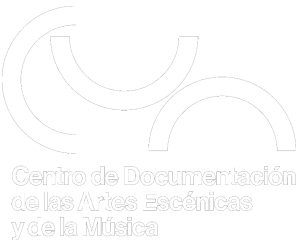Ballet Español Pilar López Programa de mano
Detalles de publicación: London: Stoll Theatre, [1957]Descripción: [4] h. ; 22x15 cmTipo de contenido: Texto (visual) Tipo de medio: sin mediación Tema(s): López, Pilar 1907-2008 | Ballet Español de Pilar López | Danza | Programas de mano -- Programas| Tipo de ítem | Biblioteca de origen | Colección | Ubicación en estantería | Signatura | Estado | Notas | Fecha de vencimiento | Código de barras | Reserva de ítems |
|---|---|---|---|---|---|---|---|---|---|
| Programas de Mano | CDAEM | Monografías Danza | Retiro | D (M) - 669 | Disponible | Temporadas, Festivales, Anuarios, Ciclos, Memorias de actividades | 0025353262791 |
En la cub.: Stoll Theatre.
Stoll Theatre, Kingsway. Peter Daubeny presentations Ltd by arrangement with Leon Hepner: Ballet Español Pilar Lopez, created by Argentinita, choreography by Pilar Lopez with Roberto Ximenez, Manolo Vargas, Elvira Real, Alberto Lorca, Paco de Ronda, Dorita Ruiz, Encarnación Mendoza, Pilar Calvo, Luis Maravillas (guitarrist), Ramon de Loja (flemenco[sic] singer), Abraham Thevenet Echaniz (pianist), Orchestra under the direction of Jose Maria Franco and Francis Chagrin, Tomas Rios (general manager)
Programme: 1. Hacia la Venta: prelude/ music by Jose María Franco. 2. Eritana (the famous composer Albeniz took from the popular "Sevillanas" (Andaluz Folk-Lore) the theme for his composition which belongs to the "Suite Iberia".Pilar Lopez adapted the steps from the "Sevillanas" for the choreography of this dance/ music by Albeniz. 3. Zambra (The gipsy escapes from the Mountain Police and dances with joy as his new-found freedom)/ music by Turina. 4. Danza castellana: a) Con el alba/ music by Gombao. b) Canción y danza/ music by Navarro. 5. Zapateado (this famous violin piece serves as a medium to exhibit the dancers' virtuosity)/ music by Sarasate. 6. Solea por Bulerias/ music by Lopez Tejera. 7. Fantasia Goyesca (inspired by the paintings and cartoons of the inmortal Aragonese painter Goya, this scene appropriately ends with the Jotas of Valencia and Aragon. It was originally presented at the New York Metropolitan Opera House in 1943, with choreography by Argentinita and Pilar Lopez: a) Majos y Duquesas; b) Fandango del Candil; c) Jugando al Toro; d) La Vendimia; e) La Maja y el Ruisenor [sic]; f) El piropo; g) Los Caprichos y Se La Llevaron; h) Jotas Aragonesas y Valencianas/ music by Granados. 8. Agua Azucarillos y Aguardiente (a typical Madrid musical comedy of the 19th Century): a. Barquilleros y Aguadoras, b. Seguidillas, c. Vals, d. La Bronca, e. Pasacalle/ music by Chueca. 9. Alborada de Gracioso ( this famous and difficult piece of music by Ravel with its intricate rhytjm unites the two techniques of the Spanish school, the "Bolera" and the "Zapateado"/ Music by Ravel. 10. Los Cabales (Flamenco picture): (The magical rhythm of the gipsy "Seguiriyas" is a ritual which captivates the "Bailora" who expressed in her interpretation the sadness and passion of the gipsy race)/ music by Tejera, Serrano and Soirt. First performed at the Teatro Fontalba in Madrid, 9th June, 1946. 11. Temas de Espana [sic]/ Music by Romas Rios-Garzon. 12. Bolero/ Music by Ravel. First performed at the New York Metropolitan Opera House in 1942.
1., 2. Pilar Lopez, Elvira Real, Dorita Ruiz, Encarnación Mendoza. 3. Manolo Vargas. 4. Pilar Lopez, Elvira Real, Roberto Ximenez. 5. Alberto Lorca and Paco de Ronda. 6. Luis Maravillas (Guitar solo). 7.a. Pilar Lopez, Elvira Real, Roberto Ximenez, Manolo Vargas; 7.b. Elvira Real and Paco de Ronda. 7.c. Roberto Ximenez and Manolo Vargas. 7.d. Elvira Real, Roberto Ximenez, Manolo Vargas; 7.e. Pilar Lopez, Roberto Ximenez, Manolo Vargas; 7.f. Elvira Real and Paco de Ronda; 7.g. Dorita Ruiz, Roberto Ximenez, Manolo Vargas; 7.h. Pilar Lopez, Elvira Real, Dorita Ruiz, Encarnación Mendoza, Roberto Ximenez, Manolo Vargas, Alberto Lorca, Paco de Ronda. 8. a. Pilar Lopez, Elvira Real, Roberto Ximenez, Manolo Vargas. 8.b. Pilar Lopez. 8.c. Encarnación Mendoza and Paco de Ronda. 8.d.; 8.e. Pilar Lopez, Elvira Real, Roberto Ximenez, Manolo Vargas. 9. Alberto Lorca. 10. Pilar Lopez, Manolo Vargas, Paco de Ronda, Luis Maravillas, Ramon de Loja. 12. Pilar Lopez, Elvira Real, Dorita Ruiz, Encarnación Mendoza, Roberto Ximenez, Manolo Vargas, Alberto Lorca, Paco de Ronda; choreography by Argentinita and Pilar Lopez.



